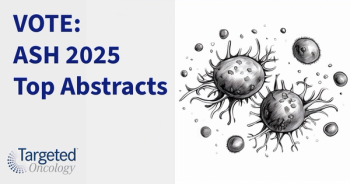
When to Consider the "Watch and Wait" Approach in MCL
In a presentation during the 2018 SOHO Annual Meeting, Simon Rule, MD, PhD, discusses the treatment of newly-diagnosed patients with MCL, emphasizing the benefits of the watch-and-wait approach.
Simon Rule, MD, PhD
It is not always necessary to treat young fit patients with mantle cell lymphoma (MCL) in the frontline if they are asymptomatic, according to Simon Rule, MD, PhD. In fact, treatment may do more harm than good, he said, as it burdens the patient and can cause unnecessary toxicities.
In a presentation during the 2018 SOHO Annual Meeting, Rule, professor of hematology at Plymouth University Medical School, United Kingdom, discussed the treatment of newly-diagnosed patients with MCL, emphasizing the benefits of the watch-and-wait approach.
If a patient is symptomatic and requires therapy, the current MCL algorithm advises that if the patient is fit for an autograft, then they will receive a rituximab (R; Rituxan) and HD-AraCcontaining regimen, and if they achieve a partial or complete response, they will undergo an autograft, and then receive maintenance. If a patient is not fit for an autograft, they are then considered for CHOP, if they are fit then they will receive R-CHOP or R-bendamustine followed by rituximab maintenance. If the patient is not fit for CHOP, they will receive R-bendamustine, R-cyclophosphamide, vincristine, and prednisone (R-CVP), or R-chlorambucil (R-Cbl), and then move onto maintenance.
Patients who are asymptomatic should be considered for the watch-and-wait approach, and if the disease becomes aggressive, treatment can then be initiated.
"I have been watching and waiting in MCL for a long timewell over a decade. People thought I was mad when I was doing it to start off with. Now, it has become quite well-established," said Rule, in an interview withTargeted Oncology. "Watching and waiting does not disadvantage patients. If patients are asymptomatic with low-volume disease, it is the right thing to do. There is no advantage in treating somebody early at diagnosis if they are well."
A study in the UK is aiming to establish a biobank and database as a national resource for characterizing indolent and aggressive forms of MCL. Upon registration, there is a central data collection to record clinical data and diagnostic samples, tissue repositories, and genetic, molecular, and immunological laboratory studies.
In the study, patients either undergo upfront therapy or the watch-and-wait approach. Data on the date, type of therapy, and reason for treatment are recorded for those receiving upfront therapy, and for those undergoing observation, when therapy does eventually begin, date, treatment type, and reason for treatment will be recorded as well. Date and cause of death will also be recorded for both groups.
Aside from traditional chemotherapy regimens, agents such as bortezomib (Velcade) and lenalidomide (Revlimid) have been studied as first-line therapy for patients with MCL. Some of the most highly-anticipated data, though, is with the BTK inhibitor ibrutinib (Imbruvica).
The SHINE study (NCT01776840) is a phase III trial of ibrutinib in combination with bendamustine plus rituximab in patients with newly-diagnosed MCL. Patients are randomized to 1 of 2 arms. The first arm is placebo orally once daily plus 90 mg/m2of bendamustine intravenously (IV) on days 1 to 2, cycles 1 to 6, plus rituximab at a dose of 375mg/m2IV on day 1, cycles 1 to 6. If complete or partial response is achieved, 375 mg/m2of rituximab is given on day 1 of every second cycle for a maximum of 12 cycles. The second arm is 560 mg of oral ibrutinib once daily plus IV bendamustine at a dose of 90 mg/m2on days 1 to 2, cycles 1 to 6, plus rituximab at a dose of 375mg/m2IV on day 1, cycles 1 to 6. If a patient achieves a complete or partial response, 375 mg/m2of rituximab is administered on day 1 of every second cycle
for a maximum of 12 cycles.
The primary objective of this study is progression-free survival. Secondary objectives include overall survival, complete response rate, overall response rate, duration of response, and safety.
In older patients with MCL, CHOP or bendamustine-based therapies can be appropriate to use, said Rule. There are currently studies in this population to determine the optimal frontline therapy for older patients.
ENRICH is an NCI multicenter, randomized, open label phase II/III trial of rituximab plus ibrutinib versus rituximab plus chemotherapy in elderly patients with MCL. Patients on this trial are being randomized to either rituximab plus chemotherapy, which is considered the standard of care, or ibrutinib plus rituximab.
“Clinical trials are how we improve outcomes,” concluded Rule. “New agents are rapidly moving into the frontline, and are likely to be a part of the standard of care soon.”









































